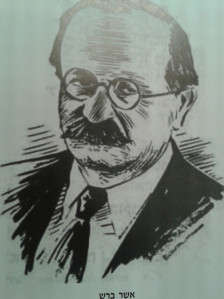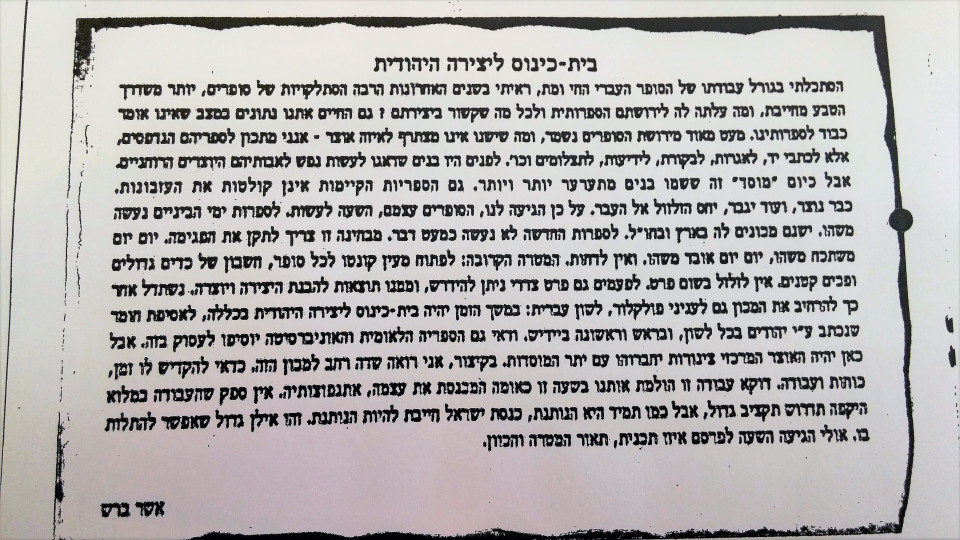GNAZIM INSTITUTE- THE ASSOCIATION OF HEBREW WRITERS, ISRAEL
The Gnazim Institute of the Hebrew Writers Association in Israel is the largest Hebrew literature archive in the world.
More than 800 archival collections of writers, poets, essayists and playwrights from the late 19th century to the present, are preserved here. Among the literary artists whose archives are kept in Gnazim are Y.L. Gordon, Shaul Tchernichovsky, Yosef Haim Brenner, Yehuda Burla, Rachel Bluvstein, Esther Raab, Leah Goldberg and Zelda Mishkovsky, as well as well-known contemporary writers including Yona Wallach, Avot Yeshurun, Yehuda Atlas, Nachum Gutman and Yonatan Ratosh.
The collections include manuscripts, letters, various personal documents and photographs, as well as a unique collection of recordings. Included are manuscripts and letters of writers who perished in the Holocaust, among them David Vogel, Hillel Zeitlin and Shimon Dubnov. The archives of well-known Yiddish authors, including Zvi Eisenman, Mordechai Tzanin, and the important archive of David Hofstein, who was executed in the Soviet Union in 1952, are also preserved in Gnazim.

The archive was established in 1951 by the Hebrew Writers Association in Israel, at the initiative of the writer and editor Asher Barash. The purpose of the archive was to assemble and preserve the works of the Hebrew authors who lived and worked in different countries and in Israel. After Barash’s death, the institute was named after him.
Researchers, academics and journalists from Israel and the world use the archive’s treasures for their studies, books or film making.
Thes archive provides an on-line catalogue and gradually makes documents available on-line for the public’s benefit.
We can be reached by e-mail: gnazim11@bezeqint.net and by phone: 03-7240549
A MESSAGE FROM Gnazim
Chairperson, ADIVA GEFFEN
To tell you something about the Gnazim archive, I’ll begin with a true story. One day in the late 1930s one of our prominent Hebrew poets, Shaul Tchernichovsky (a difficult name to pronounce), who was a pediatrician by profession, was sitting in his hospital office when an idea for a poem came to him. He wanted to write it down, but obviously there were no computers or typewriters, and even paper was often scarce. He picked up the calendar on his desk, a calendar from a pharmaceutical company with an advertisement for a laxative, and wrote down the poem—a poem that to this day is still taught in all Israeli schools. A true classic. Today this calendar, with his handwriting and including all the erasures and corrections, is stored in the Gnazim archive. You may ask, what is so special about this? Think about a stamp, the Penny Black stamp, which was sold for 100,000 dollars because only one of its kind exists. The same is true for our poet’s calendar. Naturally, no one will pay that amount of money for this calendar, but for Israeli culture and heritage it is extremely valuable, perhaps even more than the Penny Black stamp. The Gnazim archive stores millions of manuscripts of poems and books, some written on cigarettes packets, along with letters and other materials these Hebrew poets and authors wrote and kept. Gnazim, part ofthe Hebrew Writers Association in Israel, is the world’s largest archive of Hebrew literature. It includes the personal archives of 800 prominent creative artists who worked in Hebrew, as well as millions of artifacts. Recently Gnazim initiated a huge project to scan the entire archive, in collaboration with Harvard University.

An Archive of Jewish Literary Creativity
by Asher Barash, 1951
I have reflected at the fate of works by Hebrew writers, alive or dead, as I have seen in recent years many authors disappear, more than nature’s way oblige. There is no knowledge as to the whereabouts of their literary heritage and anything related to their work. Even those writers living among us, do not have the necessary amenities to honor our literature. Very little of their heritage is preserved, and whatever exists does not add up to something of value – I do not mean published books, but manuscripts, letters, reviews, newspaper clips, photos etc. In the past, there were sons who kept the endeavor of their spiritual fathers. Today this “institution”, meaning sons, is collapsing. The existing libraries cannot absorb the estates. There is a growing attitude of disrespect toward the past. Therefore, the time has come for us, the writers, to act. While the Middle Ages literature is being taken care by institutions in Israel and abroad, almost nothing has been done for the current literature. This flaw must be corrected. Every day something is forgotten, every day something is lost. It must not be delayed. The immediate goal: to open an “account” for each writer, consisting of small or large items. Nothing is to be underestimated. A miniscule detail sometimes brings results to better understand the writer and his creative work. In the course of time, we shall try to enlarge the institution and include material of folklore, Hebrew language: in due time it will be an archive and gathering place for the entire Jewish creative work, for collecting writings by Jews in any language, first and foremost – Yiddish. Undoubtedly, the National Library and the University will continue their work, but here will be the main treasure: pipes will connect it to the other establishments. In short, I see a wide field for this institution. It is worthwhile to dedicate time, effort and work. At this moment, when our nation embraces forces and assembles the diaspora, it is appropriate for us to perform this mission. A work of such extent will require a great budget, the Israeli Knesset has to be the one to see to it. The time may have arrived to publish a plan and a description of our aims and direction.
80

